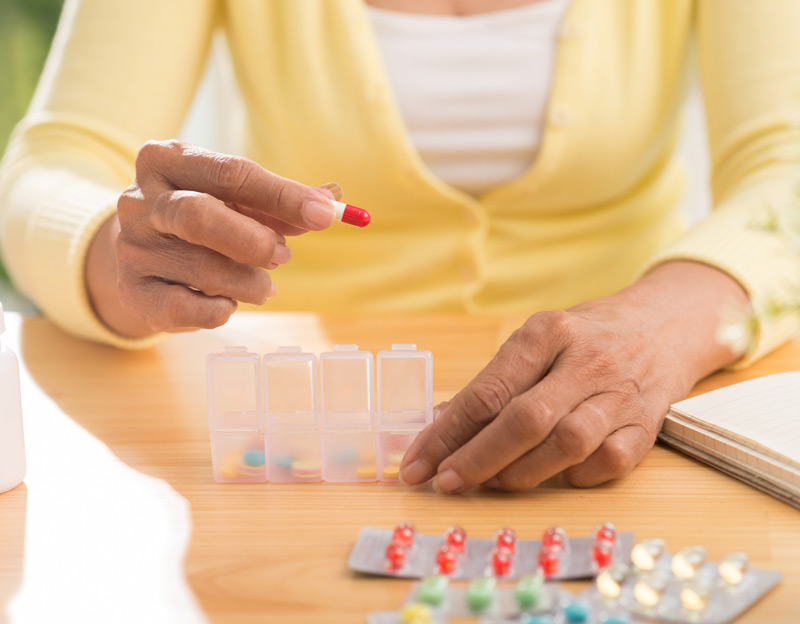

Calaid Home Healthcare, LLC has a team of nurses and health care professionals offering medication and pain management to patients diagnosed with a variety of conditions.
Types of Pain
Pain refers to any kind of unpleasant or uncomfortable sensation in the body. Though there are many different types and causes of pain, there are eight different categories that are used to inform pain management:
- Acute pain
- Breakthrough pain
- Chronic pain
- Soft tissue pain
- Bone pain
- Referred pain
- Nerve pain
- Phantom pain

Acute Pain: This type of pain comes on suddenly and only lasts for a short period of time (i.e, minutes, hours, a couple of days, or maybe a month or two). Acute pain is usually caused by a specific event or injury, such as:
- A broken bone
- A fall
- A car crash or other type of accident
- Surgery
- Burns or cuts
- Labor and childbirth
- Dental work
Chronic Pain: Chronic pain persists for longer than six months and is felt on most days. It may have begun as acute pain, but has failed to heal or resolve after treatment. Chronic pain can range from mild to severe and is associated with the following conditions:
- Arthritis
- Fibromyalgia
- Back pain
- Cancer
- Headache
- Circulation problems
- Diabetes
Chronic pain can have a severe impact on the quality of a person’s life, preventing them from returning to work or participating in physical activity. Some individuals may even experience depression or social isolation.
Breakthrough Pain: Breakthrough pain is characterized by a sudden, short, and sharp increase in pain that occurs in people who are taking medication to relieve chronic pain caused by conditions such as cancer, arthritis, or fibromyalgia. Breakthrough pain may also be called a pain flare and it may occur during exercise or physical activity, stress, illness, coughing, or between pain medication doses. This type of pain is often severe, but the location and source of the pain is usually the same as the chronic pain.
Pain Management
Depending on the patient’s condition, they may be prescribed the following types of pain-relieving medications:
- Nonopioids. Different from morphine (an opioid) and not addictive (aspirin, acetaminophen, NSAIDs)
- Adjuvant treatments. Helps relieve pain by relieving inflammation or by improving the functioning of other systems (capsaicin cream, cannabidiol, gabapentin)
- Combination opioids. Contain a nonopioid and either a weak opioid or a strong opioid (acetaminophen and hydrocodone)
- Weak opioids. Similar to morphine (an opioid) but not as strong (tramadol, codeine)
- Strong opioids. Contains morphine or similar to morphine, with the potential to cause addiction (morphine, fentanyl, oxycodone)
- Nonpharmacological treatments. Drug-free treatments such as psychotherapy or counseling.
Pain Management for Specific Types of Pain
Depending on the type of pain, patients may receive specific types of medication:
- Acute pain. Nonopioids, weak opioids, opioids, nonpharmacological treatments such as ice or bioelectric therapy
- Chronic pain. Nonopioids, antidepressants, capsaicin cream, opioids, weak opioids, nonpharmacological treatments such as bioelectric therapy and radiation therapy
- Breakthrough pain. Short-acting opioid, nonpharmacological treatments such as acupuncture or relaxation techniques
- Bone pain. Nonopioids, bisphosphonates, nutritional supplements, opioids, surgery
- Nerve pain. Antidepressants, capsaicin cream, anticonvulsants, nonpharmacological treatments such as cognitive-behavioral therapy
- Soft tissue pain. Nonopioids, corticosteroids, nonpharmacological treatments such as physiotherapy, ice, or ultrasonography
- Phantom pain. Nonopioids, ketamine, antidepressants, anticonvulsants, nonpharmacological treatments such as acupuncture or repetitive transcranial magnetic stimulation (rTMS)
- Referred pain. Cold/warm compresses, nonopioids, nonpharmacological treatments such as massage or transcutaneous electrical nerve stimulation (TENS).
